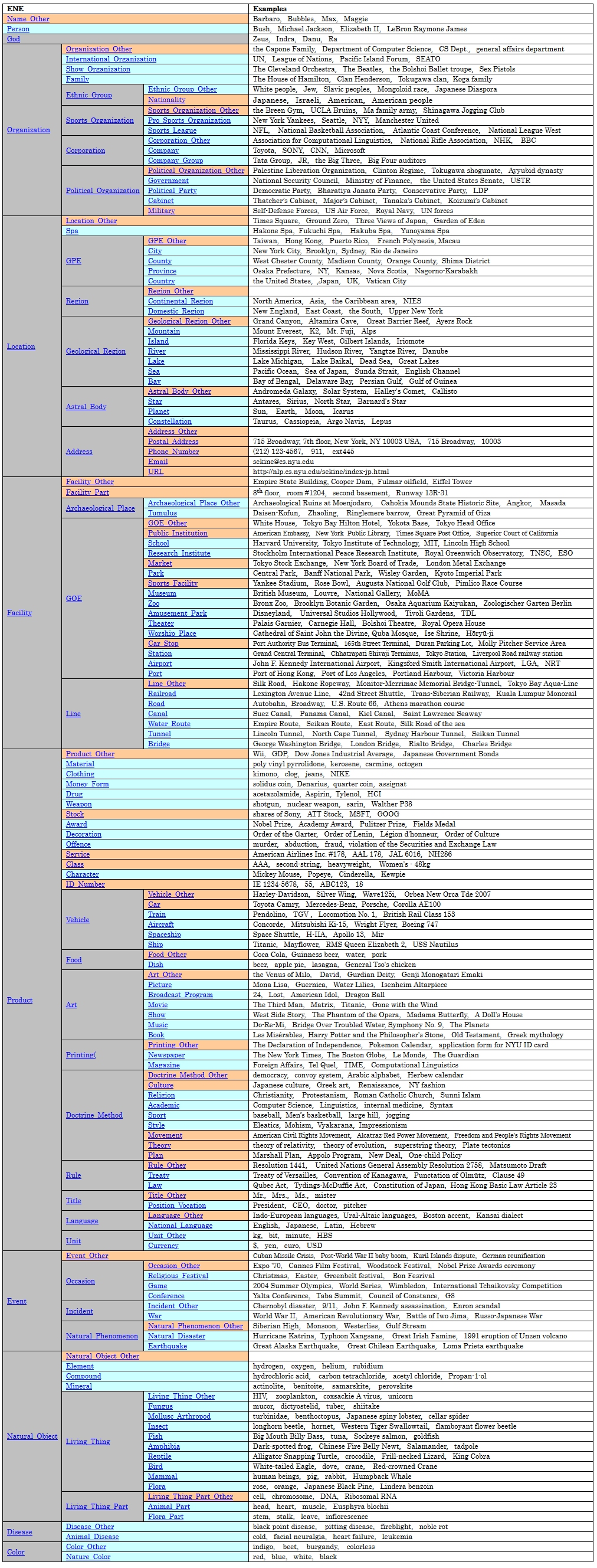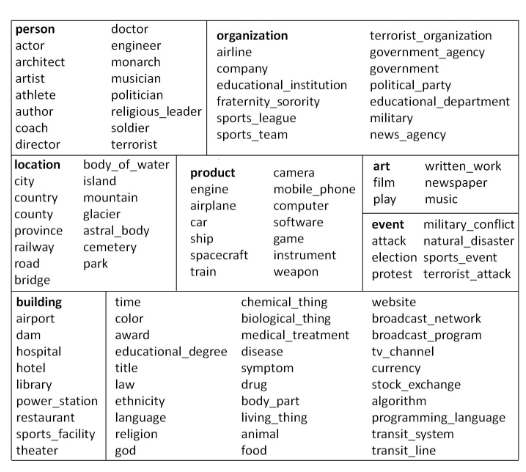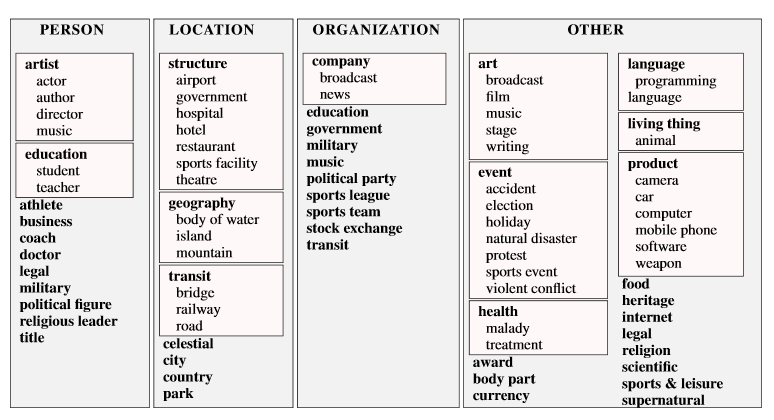 A Typology Design Aids Continuous, Logical Typing
A Typology Design Aids Continuous, Logical Typing
Entity recognition or extraction is a key task in natural language processing and one of the most common uses for knowledge bases. Entities are the unique, individual things in the world, and are also sometimes used to characterize some concepts [1]. Context plays an essential role in entity recognition. In general terms we may refer to a thing such as a camera; but a photographer may want more fine-grained distinctions such as SLR cameras or further sub-types like digital SLR cameras or even specific models like the Canon EOS 7D Mark II or even the name of the photographer’s favorite camera, such as ‘Shutter Sue‘. Capitalized names (as is the reference source for named entity recognition) often signals we are dealing with a true individual entity, but again, depending on context, a named automobile such as Chevy Malibu may refer to a specific car or to the entire class of Malibu cars.
The “official” practice of named entity recognition began with the Message Understanding Conferences, especially MUC-6 and MUC-7, in 1995 and 1997. These conferences began competitions for finding “named entities” as well as the practice of in-line tagging [2]. Some of these accepted ‘named entities‘ are also written in lower case, with examples such as rocks (‘gneiss’) or common animals or plants (‘daisy’) or chemicals (‘ozone’) or minerals (‘mica’) or drugs (‘aspirin’) or foods (‘sushi’) or whatever. Some deference was given to the idea of Kripke’s “rigid designators” as providing guidance for how to identify entities; rigid designators include proper names as well as certain natural kinds of terms like biological species and substances. Because of these blurrings, the nomenclature of “named entities” began to fade away. Some practitioners still use the term of named entities, though for some of the reasons outlined in this paper, Structured Dynamics prefers simply to use entity.
Much has changed in the twenty years since the seminal MUC conferences regarding entity recognition and characterization. We are learning to adopt a very fine-grained approach to entity types and a typology design suited to interoperating (“bridging”) over a broad range of viewpoints and contexts. Most broadly, the idea of fine-grained entity types has led us to a logically grounded typology design.
The Growing Trend to Fine-Grained Entity Types
Beginning with the original MUC conferences, the initial entity types tested and recognized were for person, organization, and location names [3]. However, it did not take long for various groups and researchers to want more entity types, more distinctions. BBN categories, proposed in 2002, were used for question answering and consisted of 29 types and 64 subtypes [4]. Sekine put forward and refined over many years his Extended Entity Types, which grew to about 200 types [5], as shown in this figure:

These ideas of extended entity types helped inform a variety of tagging services over the past decade, notably including OpenCalais, Zemanta, AlchemyAPI, and OpenAmplify, among others. Moreover the research community also expanded its efforts into more and more entity types, or what came to be known as fine-grained entities [6].
Some of these produced more formal organizations of entity type classifications. This one, from Ling and Weld proposed 112 entity types in 2012 [7]:

Another one, from Gillick et al. in 2014 proposed 86 entity types [8], organized, in part, according to the same person, organization, and location types from the earliest MUC conferences:

These efforts are also notable because machine learners have been trained to recognize the types shown. What entity types are covered, the different conceptions of the world, and how to organize entity types varies broadly across these references.
The complement to entity extraction for unstructured text is to label the text in the first place. For this, a number of schema presently exist that provide vocabularies of entity types and standard means for tagging text. These include:
- DBpedia Ontology: 738 types [9]
- schema.org: 636 types [10]
- YAGO: 505 types; see also HYENA [11]
- GeoNames: 654 “feature codes” [12]
In Structured Dynamics’ own work, we have mapped the UMBEL knowledge graph against Wikipedia content and found that 25,000 nodes, or more than 70 percent of its 35,000 reference concepts, correspond to entity types [13]. These mappings provide typing connections for millions of Wikipedia articles. The typing and organization of entity types thus appears to be of enormous importance in modeling and leveraging the use of knowledge bases.
When we track the coverage of entity types over the past two decades we see logarithmic growth [13]:

This growth in entity types comes from wanting to describe and organize things with more precision. Tagging and extracting structured information from text are obviously a key driver. Yet, for a given enterprise, what is of interest — and at what depth — for a particular task varies widely.
The fact that knowledge bases, such as Wikipedia (but, the lesson applies to domain-specific ones as well), can be supported by entity-level information for literally thousands of entity types means that rich information is available for driving the finest of fine-grained entity extractors. To leverage this raw, informational horsepower it is essential to have a grounded understanding of what an entity is, how to organize them into logical types, and an intensional understanding of the attributes and characteristics that allow inferencing to be conducted over these types. These understandings, in turn, point to the features that are useful to machine learners for artificial intelligence. These understandings also can inform a flexible design for accommodating entity types from coarse- to fine-grained, with variable depth depending on the domain of interest.
Natural Classes and Typologies
We take a realistic view of the world. That is, we believe that what we perceive in the world is real — it is not just a consequence of what we perceive and can be aware of in our minds [14] — and that there are forces and relationships in the world independent of us as selves. Realism is a longstanding tradition in philosophy that extends back to Aristotle and embraces, for example, the natural classification systems of living things as espoused by taxonomists such as Agassiz and Linnaeus.
Charles Sanders Peirce, an American logician and scientist of the late 19th and early 20th centuries, embraced this realistic philosophy but also embedded it in a belief that our understanding of the world is fallible and that we needed to test our perceptions via logic (the scientific method) and shared consensus within the community. His overall approach is known as pragmatism and is firmly grounded in his views of logic and his theory of signs (called semiotics or semeiotics). While there is absolute truth, it actually acts more as a limit, to which our seeking of additional knowledge and clarity of communication with language continuously approximates. Through the scientific method and questioning we get closer and closer to the truth and to an ability to communicate it to one another. But new knowledge may change those understandings, which in any case will always remain proximate.
Peirce’s own words can better illustrate his perspective [15], some of which I have discussed elsewhere under his idea of “natural classes” [16]:
“Thought is not necessarily connected with a brain. It appears in the work of bees, of crystals, and throughout the purely physical world; and one can no more deny that it is really there, than that the colors, the shapes, etc., of objects are really there.” (Peirce CP 4.551)
“What if we try taking the term “natural,” or “real, class” to mean a class of which all the members owe their existence as members of the class to a common final cause? This is somewhat vague; but it is better to allow a term like this to remain vague, until we see our way to rational precision.” (Peirce CP 1.204)
“. . . it may be quite impossible to draw a sharp line of demarcation between two classes, although they are real and natural classes in strictest truth. Namely, this will happen when the form about which the individuals of one class cluster is not so unlike the form about which individuals of another class cluster but that variations from each middling form may precisely agree.” (Peirce CP 1.208)
“When one can lay one’s finger upon the purpose to which a class of things owes its origin, then indeed abstract definition may formulate that purpose. But when one cannot do that, but one can trace the genesis of a class and ascertain how several have been derived by different lines of descent from one less specialized form, this is the best route toward an understanding of what the natural classes are.” (Peirce CP 1.208)
“The descriptive definition of a natural class, according to what I have been saying, is not the essence of it. It is only an enumeration of tests by which the class may be recognized in any one of its members. A description of a natural class must be founded upon samples of it or typical examples.” (Peirce CP 1.223)
“Natural classes” thus are a testable means to organize the real objects in the world, the individual particulars of what we call “entities”. In Structured Dynamics’ usage, we define an entity as something that is an individual object, either real or mental such as an idea, either a part or a whole, and that has:
- identity, which can be referred to via symbolic names
- context in relation to other objects, and
- characteristic attributes, with some expressing the essence of what type of object it is.
The key to classification of entities into categories (or “types” as we use herein) is based on this intensional understanding of attributes. Further, Peirce was expansive in his recognition of what kinds of objects could be classified, specifically including ideas, with application to areas such as social classes, man-made objects, the sciences, chemical elements and living organisms [17]. Again, here are some of Peirce’s own words on the classification of entities [15]:
“All classification, whether artificial or natural, is the arrangement of objects according to ideas. A natural classification is the arrangement of them according to those ideas from which their existence results.” (Peirce CP 1.231)
“The natural classification of science must be based on the study of the history of science; and it is upon this same foundation that the alcove-classification of a library must be based.” (Peirce CP 1.268)
“All natural classification is then essentially, we may almost say, an attempt to find out the true genesis of the objects classified. But by genesis must be understood, not the efficient action which produces the whole by producing the parts, but the final action which produces the parts because they are needed to make the whole. Genesis is production from ideas. It may be difficult to understand how this is true in the biological world, though there is proof enough that it is so. But in regard to science it is a proposition easily enough intelligible. A science is defined by its problem; and its problem is clearly formulated on the basis of abstracter science.” (Peirce CP 1.227)
A natural classification system is one, then, that logically organizes entities with shared attributes into a hierarchy of types, with each type inheriting attributes from its parents and being distinguished by what Peirce calls its final cause, or purpose. This hierarchy of types is thus naturally termed a typology.
An individual that is a member of a natural class has the same kinds of attributes as other members, all of which share this essence of the final cause or purpose. We look to Peirce for the guidance in this area because his method of classification is testable, based on discernable attributes, and grounded in logic. Further, that logic is itself grounded in his theory of signs, which ties these understandings ultimately to natural language.
Logic and the Typology Design
Unlike more interconnected knowledge graphs (which can have many network linkages), typologies are organized strictly along these lines of shared attributes, which is both simpler and provides an orthogonal means for investigating type class membership. Further, because the essential attributes or characteristics across entities in an entire domain can differ broadly — such as living v inanimate things, natural things v man-made things, ideas v physical objects, etc. — it is possible to make disjointedness assertions between entire groupings of natural entity classes. Disjoint assertions combined with logical organization and inference mean a typology design that lends itself to reasoning and tractability.
The idea of nested, hierarchical types organized into broad branches of different entity typologies also provides a very flexible design for interoperating with a diversity of world views and degrees of specificity. The photographer, as I discussed above, is interested in different camera types and even how specific cameras can relate to a detailed entity typing structure. Another party more interested in products across the board may have a view to greater breadth, but lesser depth, about cameras and related equipment. A typology design, logically organized and placed into a consistent grounding of attributes, can readily interoperate with these different world views.
A typology design for organizing entities can thus be visualized as a kind of accordion or squeezebox, expandable when detail requires, or collapsed to more coarse-grained when relating to broader views. The organization of entity types also has a different structure than the more graph-like organization of higher-level conceptual schema, or knowledge graphs. In the cases of broad knowledge bases, such as UMBEL or Wikipedia, where 70 percent or more of the overall schema is related to entity types, more attention can now be devoted to aspects of concepts or relations.
The idea that knowledge bases can be purposefully crafted to support knowledge-based artificial intelligence, or KBAI, flows from these kinds of realizations. We begin to see that we can tease out different aspects of a knowledge base, each with its own logic and relation to the other aspects. Concepts, entities, attributes and relations — including the natural classes or types that can logically organize them — all deserve discrete attention and treatment.
Peirce’s consistent belief that the real world can be logically conceived and organized provides guidance for how we can continue to structure our knowledge bases into computable form. We now have a coherent base for treating entities and their natural classes as an essential component to that thinking. We can continue to be more fine-grained so long as there are unique essences to things that enable them to be grouped into natural classes.






